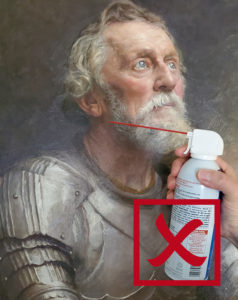A question that often comes up is – Can I clean/dust my painting? The answer to this is yes, but you need to know how to do it safely.
If you acquired the work from a gallery, they should have had a conservator take care of any ‘major’ cleaning that was needed. This would include the removal of any surface dirt and old, discolored, varnish. Once cleaned, a new layer of varnish would then be applied — to help seal the original paint surface. If, on the other hand, you acquired your work from some other source (i.e., inherited a work that has been in the family for many years), you may want to have a conservator look at it to determine if it needs to be professionally cleaned. Once completed, the work will have a bright /fresh appearance and is ready to be displayed in your home.
Paintings, unlike other items in your home, need very little day-to-day care; however, after the work has been hanging in your home for an extended period, you may feel the desire to dust it. Years ago, I was speaking with two – longtime – clients and friends. Each of them had decided that it was time to dust their works. The first, jokingly, asked if he could use his leaf blower … we both laughed, and I told him it would be fine, but I could not guarantee that the painting would still be on the wall when he finished!! The second, in a more serious tone, asked if they could use a can of compressed air? My immediate response was you could, but you may end up blowing some, if not all, of the paint off the surface. We both laughed, and I went on to explain that what they needed to keep in mind is that the upper paint layer of a work of art is just one of many layers. Before an artist begins to paint, they cover the canvas with a layer of gesso, and some artists use more than one layer. Then a base color is added on top of the gesso, and then the artist begins to paint. Some artists will even go over areas several times – creating thicker layers in certain areas. As time passes, some of these layers may become loose or unstable, and a strong blast of air can cause them to peel away from the canvas, leaving you an area of paint loss … something we should all try and avoid.
While living in London during the early 1980s, I heard a fascinating story from a friend at one of the European auction houses. A dealer had attended a poorly publicized country estate sale and purchased a large Old Master painting. After the sale, the dealer wanted the painting examined as soon as possible, so he tied it to the top of his car and drive to London. Well, as I am sure you can guess, after arriving at the saleroom, he was horrified to see that the canvas was stripped of all the paint, leaving an old blank canvas … yes, somewhere along the M5 all the paint was blown off!!! It is a shame that no one will ever know if it was a long-lost masterpiece, or some sort of copy. While this is an extreme example, it does illustrate the point that strong gusts of air can cause damage to a work of art.
In a typical home, a painting should not be dusted more than once or twice a year and when you decide that now is the time, please make sure you use a sable (makeup), badger-hair, or soft white bristle Japanese brush. You should never use a feather duster as it can scratch the surface of the painting. Also, before starting, examine the paint surface. You want to make sure that there are no “active” areas … spots where the paint appears to be lifting or peeling. If you see areas that look unstable or notice an area where the paint has come off, do not touch the work … your next step is to contact your dealer or a conservator. As paintings age, they begin to dry out and crack (much like human skin), and there will be times when professional help is needed. There is no need to panic since most problems, when caught early enough, can be corrected with little effort and expense.
I want to stress that unless you are a conservator, never try to clean your paintings with water or household chemicals. As I mentioned earlier, most oil paintings contain a layer of gesso – many of which are water-based. If you were to use water to clean the picture, you run not only the risk of discoloring the paint surface but also reactivating the gesso, and this can cause the paint to fall off the canvas. The use of household chemicals is also a big No, No! Over the years, we have seen many works where parts of the paint surface were wiped away – something referred to as skinned or abraded. There was one instance where we had the opportunity to question the owner of a ‘skinned’ painting, and they mentioned that the housekeeper would often use one rag to dust the furniture and then wipe down the paintings. Over time those rags, soaked with furniture polish, removed layers of paint from the surface. Not a pretty sight!! Oh, and most of the work’s value was lost.
I also suggest that if you plan on renovating your home, at the very least, cover your works of art with plastic or drop cloths. It is even better if you wrap them up and place them in a closet. You will not only avoid the need to dust the works repeatedly but might even prevent any severe damage from occurring. At times, we have seen paintings that were accidentally damaged by construction workers … a ladder in the wrong place can make a BIG mess!!
Over time, you will find that the one item needing the most attention is the frame. Typically, the top and bottom edges of a frame will catch most of the dust, and this can be cleaned when need be; but again, please do this only occasionally. I suggest that you either use a very soft dry cloth or the same brush you would use on the front of the painting — a light dusting is all it should need. Never use water or household chemicals when cleaning/dusting the frame. If your frame was water-gilded, using a cloth with water can remove the gold, and using the wrong chemicals can have a similar effect. I probably should not say this, but if you are very careful, a can of compressed air will help remove dust from the hard to reach places. If you do decide to use compressed air, be sure to attach the extension tube, use very short blasts, and stay away from the work of art.
In closing, I will say that we rarely touch the works hanging in our home. We do not regularly dust the paintings, and only occasionally dust the frames. As they say, sometimes less is more!



